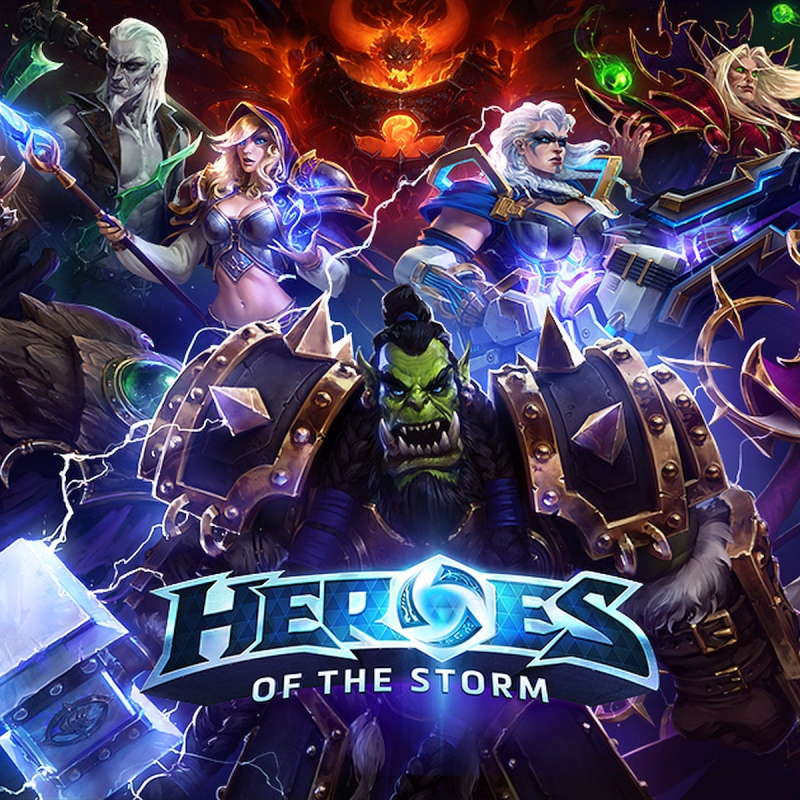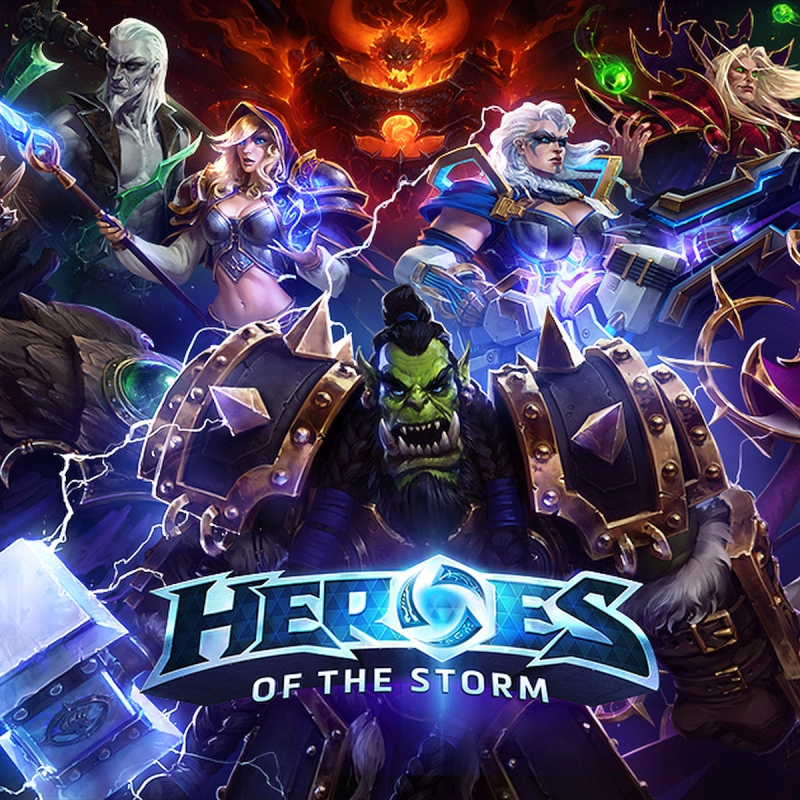Existing User Log In
New User Registration
Register for a free account to gain full access to the VGChartz Network and join our thriving community.





America - Front


America - Back

Blizzard Entertainment
Action
 (Add Date)
(Add Date) (Add Date)
(Add Date) (Add Date)
(Add Date)
| Owners: | 0 |
| Favorite: | 0 |
| Tracked: | 0 |
| Wishlist: | 0 |
| Now Playing: | 0 |
The MOBA (or Dota) genre’s history will always be tied to Blizzard. Dota was, after all, originally a wildly popular custom map for WarCraft III. Back in 2010, Blizzard announced Blizzard Dota as a custom map for StarCraft 2. After five years of significant gameplay changes, a decision to turn it into a full game, a legal battle with Valve over the use of the name “Dota”, and several title alterations, Blizzard has finally released Heroes of the Storm.
Heroes of the Storm (or HotS) is Blizzard’s attempt at taking its “easy to learn, difficult to master” game design mantra and applying it to the MOBA genre. The accessible and fun gameplay, the varying maps and heroes, along with the strong visual and audio design help Heroes of the Storm succeed as a terrific game on its own; however, there are some drawbacks that may hinder its ability to compete against MOBA giants Dota 2 and League of Legends.
At its core, the gameplay in HotS is identical to other MOBAs: two teams of five heroes work together to destroy towers and push lanes of minions while fighting one another to level up and gain more powerful abilities; the first team to destroy the other side's base is victorious. For the most part, HotS sticks closely to this tried and true format, but Blizzard has made some key alterations which makes it more accessible, while speeding it up and putting a greater emphasis on team battles.
Fortunately for newcomers to the MOBA genre, Blizzard has done an excellent job of creating an accessible and easy-to-learn game in HotS. There are several well-made tutorials that ease newcomers into the genre and explain the major concepts of the game. Experience points gained from killing minions, taking out towers, and slaying heroes are also equally spread among your team, which means your entire team levels together. This ensures that players do not fall behind their team and no one player can carry a team, putting emphasis on teamwork.
HotS sets itself apart with the removal of items. Without items, players do not need to worry about the complexities of managing their inventory and instead focus on the battles. Players do not need to worry about “last hitting” minions to gain extra gold either. However, with the removal of items, there is less customization of your hero. Blizzard tries to alleviate this by allowing players to select talents that augment or add abilities to heroes as they level up. This gives some degree of customization, but nowhere near as much as other MOBAs.
Even though it is accessible, matches in HotS are fast, furious, and genuinely exhilarating. Matches typically end in less than 30 minutes, which is much shorter than other MOBAs. There are fewer towers to destroy and they go down quickly. Towers will also periodically run out of bullets, allowing the other team to take advantage without taking significant damage. The heroes themselves are also quicker compared to other MOBAs except HoN. All of this blend together to create a fast, satisfying experience.
Blizzard encourages players to stay in battle and, when necessary, get into battle quickly. For example, did you take too much damage but still want to gain experience for your team? Drink from a well near your towers to rejuvenate a bit over time and get back into the action. You can also pick up rejuvenation pots that defeated minions periodically drop. When you have no choice but to return to your base, you can get on your mount to swiftly get back into battle. This all makes it so players are spending more time in battle.
Matches in HotS start and escalate quickly. Soon after the start of a match, an important map objective will begin. Teams will want to gather to complete the objective to gain an advantage. There are also neutral mercenary camps that, when defeated, help your team push lanes. All of this helps speed up the early laning phase of the game and emphasizes the importance of team battles and teamwork. The fast pace of HotS forces players to make quick second-to-second decisions and adds an element of excitement and unpredictability.
Blizzard has succeeded in streamlining all of the most complex elements of MOBAs, allowing new players to learn quickly and feel as though they are contributing to their team’s success. This accessibility comes at a cost, as veterans of the genre may feel that HotS lacks the depth of games like Dota 2 or League of Legends. Give it time however, and HotS reveals its own intricacies.
As of launch, there are 37 heroes available to choose from in HotS spanning a variety of Blizzard’s universes. Unlike other MOBAs, players select their hero before starting the matchmaking process. This works well in getting you into a game quickly but sacrifices pre-game communication and strategizing in the process, unless you are playing in a group. Furthermore, even though Blizzard has a lot of characters to draw from in its own universes, I wonder if they can compete with the vast amount and variety of heroes found in its rivals someday.
Being free to play, HotS borrows heavily from League of Legends’ weekly free hero rotation. Every week, players will have access to a rotation of several free heroes. Of course, players have the option of purchasing heroes and making them available at any time; either with earned in-game gold or real money. I’m disappointed Blizzard didn’t follow Dota 2’s system here, where all heroes are available for free and the only monetised aspect is cosmetic. However, you are able to sample heroes in a one-lane, offline map against bots to see if they are worth purchasing. Some heroes seem a bit too expensive for the amount of gold you receive. Fortunately, this doesn’t break the balance of the game for players who do not spend real money; unlocking characters just takes longer.
Heroes are divided into four roles: Warrior, assassin, support, and specialist. Warriors are your typical melee tank. Assassins generally have high offensive output, but are vulnerable defensively. Support characters heal or provide buffs to allies. Finally, specialists are flexible heroes who don`t fit one specific role. The heroes are all fun to play and their skills translate well from their respective games into HotS. For example, anyone who has played Raynor in StarCraft 2 will be able to adjust to him quite easily here. In this regard, Blizzard has done an excellent job.
In HotS players level up individual heroes as well as increase their own player level through experience points rewarded at the end of matches. The higher you level up a character, the more things you unlock for that character, such as talents, portraits, and skins. As your player level increases, you gain access to additional game modes, gold, free hero slots, and stimpacks, which increase the rate of gold and experience earned. Additionally, daily quests are available after reaching player level 6. Players can complete these to gain extra gold. Quests usually revolve around playing or winning a certain amount of games as a specific role, or playing heroes from one of Blizzard's game universes. This system works well in encouraging you to try different heroes but may also make you (and your matchmaking teammates) attempt a specific hero or role you're not comfortable with.
One of HotS’ strengths over other similar games is the map variety. At launch, there are seven Battlegrounds that players can compete in and each provides unique objectives and challenges. For example, in Blackheart’s Bay players must collect doubloons from neutral enemies or treasure chests to pay Blackheart to use his cannons against your enemy’s towers. Each Battleground is fun in its own way and really spices up the standard MOBA map. Unfortunately, Blizzard placed a bit too much value on the Battleground objectives. Often, it feels difficult for teams to recover after losing an early objective battle depending on the Battleground. Another problem is that in the primary competitive mode, Quick Match, players are not given a choice as to which Battleground they will play in.
HotS’ visual and audio production is also top-notch. It is one of the most graphically impressive games in the genre. The highly detailed heroes have a consistently beautiful visual style. Towers and buildings look terrific and change depending on the Battleground. Minions will go flying in spectacular fashion when they are destroyed. The characters come alive through their voices, and the sounds of battle really engross you. A nice touch that Blizzard has included is having characters automatically vocalize their thanks when you help them, in similar fashion to Dota 2 (although this may get annoying to some). The music in HotS also deserves a mention; players will hear familiar tunes from older Blizzard games along with new ones. They are catchy and I found myself humming along on several occasions.
Although HotS’ core gameplay is well-crafted, there are parts that can be frustrating. As of now, some heroes, skins, and mounts seem expensive, forcing players to grind or pay real money to unlock them. Furthermore, to unlock the ranked Hero League, players need to own 10 heroes and reach player level 30, which takes hours. In some Battlegrounds, the mission objectives can often upset the balance of the game, making it baffling that Blizzard gives players no choice of which Battleground they will play on in some of the game modes. Veterans of the genre may also be turned off by HotS’ lack of depth compared to other MOBAs. Finally, the matchmaking system needs to be reworked. In my experience, there were instances where a team had too much of a particular role, which tilts the balance of the match towards the other team. Fortunately, these issues can be addressed with future patches.
Although not perfect, Heroes of the Storm is an easy recommendation, especially for new players to MOBAs. The core gameplay is quick, accessible, and encourages teamwork, the heroes are enjoyable, and the visual and audio design is superb. These qualities are somewhat undermined by various design decisions regarding matchmaking, map objectives, and a long progression system. However, because MOBAs are constantly evolving, Heroes of the Storm can improve with future patches, and will have to do so if it wants to compete with more established titles in this fiercely competitive genre.